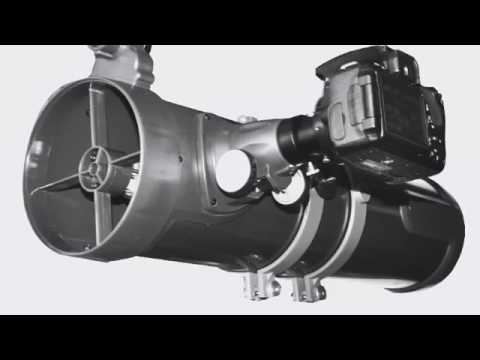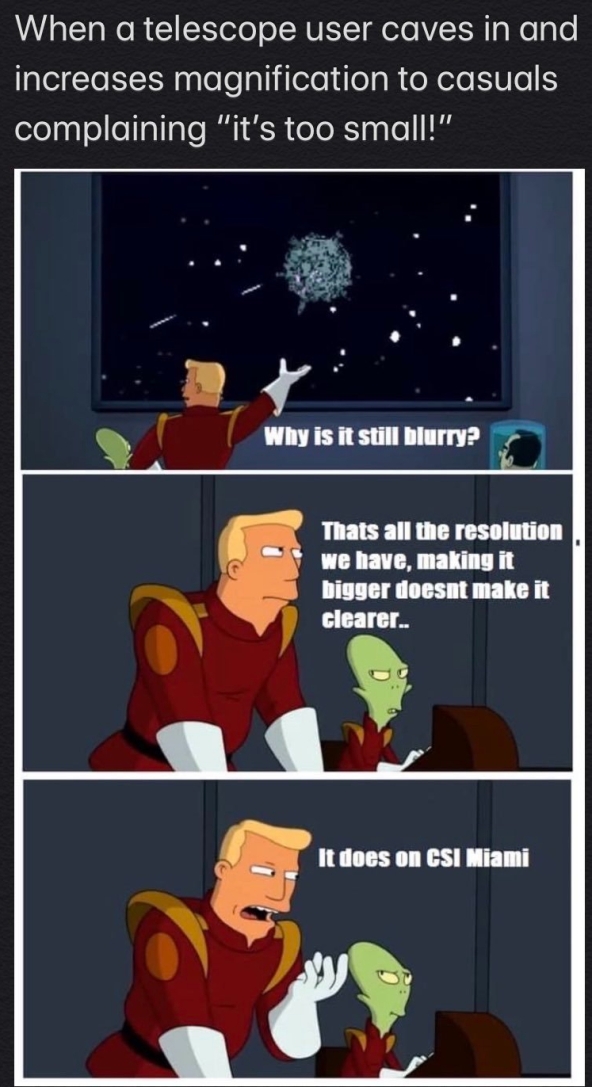Truth be told, I wouldn’t care if people get these items… they honestly seem like a fun thing to have! However, once I saw the claim of “It will replace the previous telescope in the future” on some of these social media posts… I had to say something!
If you are reading this, please share this to anyone you feel might be getting duped into buying these things!
These advertisements on social media are doing nothing but preying on the gullible and the layperson who doesn’t understand how telescope optics are supposed to work. It’s very common for people to assume that magnification is what a telescope is all about, and think that because the magnification is being advertised with a big number, then that means the telescope is “super!”
I am NOT kidding when I say that I’ve seen these same ads pop up every few postings… you click on one to investigate and all of the sudden more of these pop up in your feed! It gets more repetitive than a broken record!
If you skip to the sections that talk more about popular “zoom cameras” like the P900, and learn about how magnification works on telescopes and cameras, then you’ll get a better idea!
How to Tell If These Product Ads Are Too Good To Be True – Red Flags To Look For…
Red Flag 1 – Advertisements from different “companies” always seem to be word for word and play the same attraction video, or contain the same images/clips.
Keep scrolling down on Facebook and you’re bound to see a different “company” trying to sell you the same product under a different listing. This is more likely a black market company creating different “clones.”
Look at the images above, it’s almost word for word the same listing! These were all found within a few minutes of scrolling through Facebook!
Even if it’s not exactly the same attraction video on every listing, if you look carefully, you’ll see that they have the same clips or slideshow images in a different order.
Red Flag 2 – The actual website selling the item is selling other random merchandise.
Are there legitimate sellers based in China? Absolutely. For example, if they are selling a powerful laser, and their website is specific in making and selling lasers of different models, watts, colors, etc., then that’s much more legitimate and trustworthy. I’ve bought my astronomy presentation lasers from such vendors.
But if the actual sellers website (where social media often takes you to buy the product) is not specializing in similar items, and instead you just see a bunch of random items all on sale with a “marked down” price, then that should be a red flag if you’re interested in buying whatever you saw on social media.
Red Flag 3 – Check the Comment Section

Do you notice that there are no comments with pictures shared by people who actually got the item?
Legitimate comments may be lost in swaths of inquirers, and these sellers have also been known to delete and/or censor negative comments, and prevent accounts from further trying to warn. But I have caught the pissed off people who got fooled before their comments got removed, and as you can see, I’ve preserved some of them!
Positive comments? They’re likely bots or paid comments!
Red Flag 4 – How does the customer care contact information look, if there is any at all?
So the attraction video in the advertisement often gives you the impression that you’re buying something large enough that it needs a protective case, and requires two hands to hold carefully, and you instead end up getting something that fits entirely in the palm of your hand.
So it turns out this product you waited 2-4 weeks to arrive from China is a low quality knockoff? And there is next to ZERO customer service?
Hate to say I told you so!
“But they say on the posting that they ship from (a USA location)” If that were the case, then if you decide to return the item back to the seller, you’ll find that instead of going back to a USA address, it will have to go back to China, and the cost to return it will be worth more than the product’s value!
Red Flag 5 – The PRICE IS TOO GOOD TO BE TRUE!!
Something being advertised as a “replacement” for a telescope has a lot of balls to make that claim, especially when going against people who actually know how telescopes and optics are supposed to work!
These listings boast about how you can achieve 300x magnification with it… again, another ballsy but easily check-able claim!
Well, first off, let’s talk about the popular Nikon P900… a camera often referenced for high zoom capabilities. By default it has focal lens that goes all the way up to 2000 mm and achieves 83x… a Nikon P1000 can get to 3000, or 125x zoom, and I’m not including what you can get with their “Dynamic Fine Zoom” functions.
Both of these products start selling for as little as $500 – $800 respectively… they’re obviously not cheap.
What about telephoto lenses?
The Nikkor 70-300 mm F/4.5 to F/6.3 lens by itself without the camera body it can cost as low as a couple hundred bucks new… and as you can see in the pictures below, they definitely do the job for faraway objects in landscape and astrophotography.

This long exposure shot of the Andromeda Galaxy above was shot with a Nikon D5300 using the same Nikkor 70-300 mm focal lens mentioned prior on a tracking mount – not through a telescope.

In prime focus astrophotography where the camera body becomes the eyepiece, the telescope itself becomes the focal lens depending on the focal length involved – thus a 1000 mm focal length telescope becomes the equivalent of a 1000 mm focal lens! Oh, and let’s not forget about Barlow Lenses, which multiply the focal length depending on the specific lens. Hence, a 1000 mm scope using a 2x Barlow is now virtually 2000 mm.
To achieve 300x magnification in the telephoto lens sense, that means the focal length has to go all the way to 7200 mm! Try looking for DSLR telephoto lenses that exceed above 500 mm… they’re not that widely available, and IF they are, they’re NOT cheap! The price tags on these lenses can often cost more than the camera body itself!
Okay… What About Telescope Magnification

When it comes to telescopes, technically, you can magnify any telescope as much as you want, but if you go beyond what the scope itself can resolve, then your blurry images that become super noisy and filled with compression pixels from overdoing the Sharpen function in Photoshop will be good enough to convince people there are cities on Jupiter.
Telescopes must have an aperture of 6″ (150 mm) or wider to be theoretically capable of resolving details at 300x magnification. Magnification being used is calculated by the focal length of the telescope divided by the eyepiece being used, hence a 1000 mm focal length scope using a 25 mm eyepiece is magnifying at 40x. How would I get to 300x on a 1000 mm focal length telescope? The easiest way would be to insert a 10 mm eyepiece (100x) into 3x Barlow, which will triple the magnification into 300x.
If telescopes need to be as wide as 150 mm in diameter to even think about resolving at 300x , then how can something 35-40 mm in diameter resolve anything at that amount of zoom?!
So you’re telling me these “super nanotechnology zoom monocular telescopes” that fit in the palm of your hand and sell for cheap are going to perform like the examples mentioned prior?!
THIS…

will have the same optical quality and zoom capabilities as THIS?!

OR THIS?!

Then if you buy one of those so called “super nanotechnology zoom telescopes,” I just have two words…

With Telescopes – IT AINT ABOUT THE ZOOM!
Perhaps those things will be great for terrestrial viewing, and anything bright enough that you can see. I’m sure one would have a lot of fun zooming in on faraway landscape features or into your neighbor’s… – So yes, there is some practical use for them.
But there is absolutely no way it will replace a telescope when it comes to views of the celestial sights in the night sky! You may get the Moon, but that’s because it’s big enough and bright enough!
Here is what they don’t tell you!
- Telescopes are not glorified magnifiers, they are what we call collectors of light, or “light buckets.” The wider the scope, the more light it collects, hence the more into deep space you can see!
- Most “beginner telescopes” are between 60 – 114 mm (2.3 – 4.5 inches) in aperture. That’s anywhere between 73x to 265x light gathering power. These “nanotechnology 35mm telephoto zoom monoculars” are only collecting 25x more light than the unaided eye sees under the best conditions.
- the more you zoom in, the more that tiny movements in your hand affect how unsteady the view is… hence your FOV is prone to a lot more shaking and blurring from your hands trying to hold the thing steady!
- The more you magnify, the less light you are allowing into your eye, hence your trek into deep space and quest to see distant galaxies will most likely be nothing but black through such a small aperture device!
So much for all that zoom power, right?
Most of the time when looking at the deep sky, we observe objects at low magnification so we can allow the most light possible to see these deep sky objects. Zooming in can make closer details impossible to see because the incoming light is too dim, especially through smaller telescopes! Trying to search for anything at super high magnification is like searching for a needle in a haystack while looking through a narrow straw!
Even if you could get the thing steady enough to look at the Rings of Saturn at 300x magnfication, and somehow track it with Earth’s rotation, then your 35-40 mm aperture will be simply too small resolution and make things way too mushy to have a pleasant viewing experience!
Oh, but don’t listen to me, I’ve only been observing the sky with telescopes for the past 20 years… 3 of them professionally…
If you made it all the way to the end of this article and feel this opened your eyes, please share this to anyone who you think might be getting fooled into a newbie trap!
Once again… Things that Telescope Users Say for $200 – What is, “Don’t Drink the Magnification Kool-Aid,” Alex…
I sincerely hope that if you read this and already have purchased these items from these sellers, that the product does exactly what the advertisements said they do, and if anything, you get something that looks like the pictures! Have fun checking out what you can see over land or sea… but don’t think you’ve found anything revolutionary that puts astronomy telescopes out of commission!
If you have not bought one of these yet, save the $40 and just look for a pair of binoculars instead!

Support Your Neighborhood Astronomers!
You know where mainstream media sites get their information? From people like us! Support Your Neighborhood Astronomers! Everything is free, but donations help keep the website alive and go towards outreach events!
$1.00
















I am a sniper in the military and nanotechnology actually does exist you damn fool I can see from miles of this thing
LikeLike
Never said it doesn’t exist. Would military grade spotting scopes for Snipers be legitimately sold for $30-$40?
That’s what I’m getting at!
LikeLike
Thanks for this article! Saw the same exact ad in my Instagram feed and for a nanosecond I almost fell for it haha. But my senses kicked in and then I started looking up if anyone else recognized this scam. Good on your for getting the word out!!
LikeLiked by 1 person
Thank you! After feeling disappointed by the recent “celestial event,” the highly-touted conjunction, I’ve been mulling the idea of a backyard (actually, balcony) telescope. But as a novice there is so much to learn. Thanks for sharing the basics, along with fair warning about the “nanotechnology” in the $40 online versions.
LikeLike
I’m sorry you were disappointed by the Great Conjunction if I read that correctly… I get if it didn’t look like you’d imagine to the naked eye – but you’ll never see them get that close again – they looked great together through my scope!😁
Feel free to use the advice given on this site on selecting your first scope, and I’m always happy to help!
LikeLike
Loved your article and you saved me from being ripped off ,,Thank You !! Can you tell me what would be a good Telescope in the 200.00 to 300.00 dollar range to be able to see planets, moon and stars . It is for my husbands birthday and he saw the scam scope and now that I know it sucks what would you suggest . Thank you Shelly
LikeLike
My site has this article:
https://orionbearastronomy.com/2019/02/23/what-can-200-get-me-on-a-telescope-budget/
That will give you a good idea on what you can get for $200-$300.
If you just want ready views right out of the box, go with the Orion SkyQuest 4.5 inch Dobsonian.
LikeLike